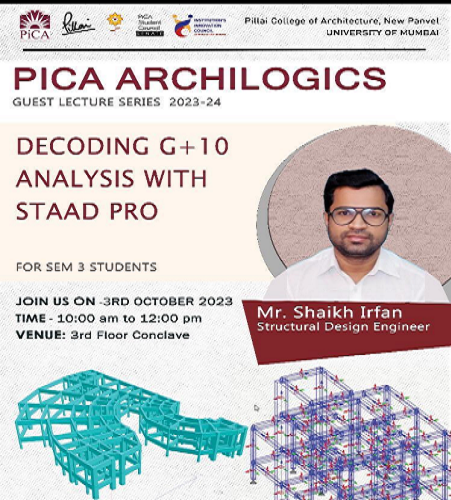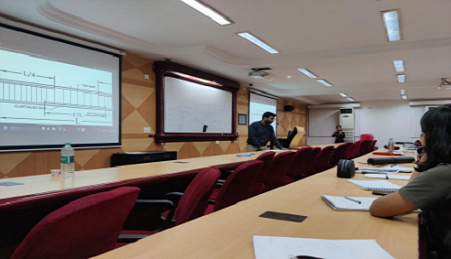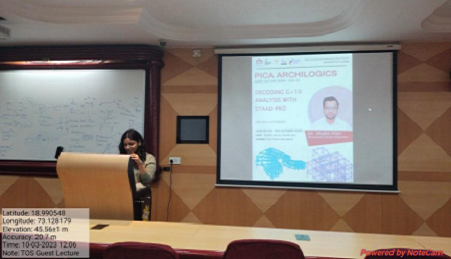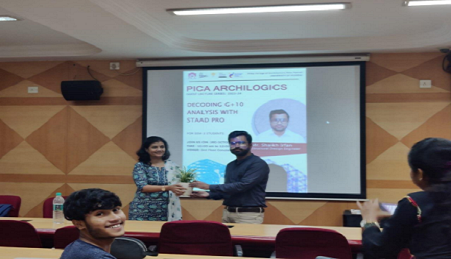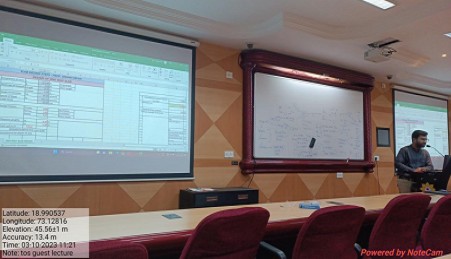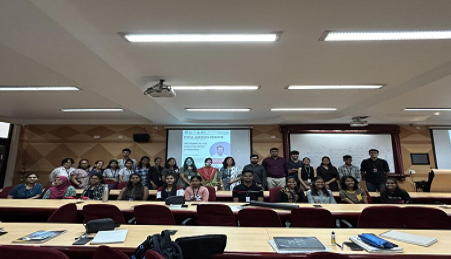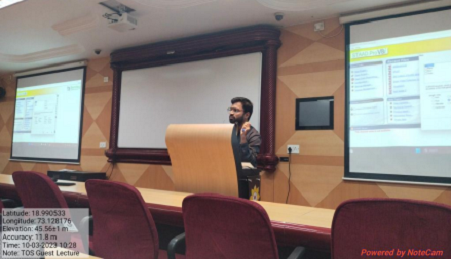| Title of the Event | Clean Air for Blue Skies |
| Subject | Theory and design of structure -III |
| Session | Morning |
| Year | 2nd |
| Date | 3rd October, 2023 |
| Time | 10:00 a.m. to 12:00 p.m. |
| Venue | 3rd floor conclave |
| Faculty Coordinators | Prof. Shital Marlapalle |
| Guest Speaker | Prof. Shaikh Irfan |
Aim:
The purpose of this analysis is to evaluate the structural integrity, stability, and performance of the given structure under various loading conditions.
Objectives:
- The primary objective of this structural analysis is to assess the structural behavior of the given structure under different loading conditions, including dead loads, live loads, wind loads, and seismic loads.
- To determine whether the structure meets safety requirements and code compliance.
When and how the event was conducted
The Guest lecture on “Decoding G+10 Analysis with STAAD-PRO” was conducted by Er. Shaikh Irfan on 3rd October, 2023 with an intention of giving student of B.Arch 2nd year an overall information of structural Detailing parameters such as planning, dimensions, material properties, column position, types of support, loading combination for the analysis of structure.
Significance of the event/topic
The primary significance of structural analysis is ensuring the safety of structures and the people who use them. By analysing the behaviour of a structure under various loads and environmental conditions, engineers can identify potential weaknesses or failure points and take steps to mitigate them. This helps prevent catastrophic failures that could result in loss of life or property.
Brief Introduction of the guest:
Name of Guest Speaker: Prof. Shaikh Irfan (Structural Design Engineer)
Education Qualification: ME (Structure) PHD Pursuing
Work Experience / Publications
- Currently working as “Assistant Professor” at Anjuman-I-Islam’s Kalsekar Technical Campus, Panvel, Navi Mumbai from 12th July 2022 to till date.
- Worked as “Assistant Professor” at “Deogiri Institute of Engineering and Management Studies Aurangabad” from 15th December 2021 to 16th July 2022.
- Worked as an “Assistant Professor” at “Saraswati College of Engineering, Kharghar” from 23rd December 2019 to 28th February 2022.
- Worked as a “Cost Consulting & Estimation & Staad Pro Structural Design Software Trainer” at “Universal School of Constructions in Association with Quosco Consultants Pvt. Ltd.” From 17th August, 2019 to 13th December, 2021
- Worked as a “Subject Matter Expert” for Ekeeda Pvd. Ltd. an online learning platform
- Worked as a “Structural Design Engineer” at “DVS Consultants & LLP, Belapur CBD Navi Mumbai” from 22nd July 2019 to 19th December, 2019.
- Published paper on “Lateral load resistance by using metallic fuses”, Resincap Journal of Science and Engineering, Volume 2, Issue 3rd March 2018, ISSN: 2456- 9976.
- Published paper on “Literature review on Lateral load resistance by using metallic”, Resin cap Journal of Science and Engineering, Volume 2, Issue 3rd March 2018, ISSN:2456-997.
Points Covered:
Analysis of structure
- Plan & dimensions
- Position of columns and their sizes
- Material properties
- Grade of concrete, Grade of cement, grade of steel
- Water cement ratio
- Mixing proportions
- Types of supports
- Loading combinations
- Design steps of slab
Brief take away of the event / lecture:
This lecture covered some of the parameters such as planning, dimensions, material properties, column position, types of support, loading combination for the analysis of structure and which helped students to understand the entire concept of Structural detailing for the analysis of structure. They understood detailed information about the structural behaviour, member forces, deflections, and design code compliance with the help of Staad pro.
The following steps of analysis of structure with STAAD PRO
- Modelling: Create a digital model of the building in STAAD. Pro. This involves defining the geometry, materials, and member properties. You will create nodes for structural connections, beams, columns, slabs, and other structural elements.
- Loading: Specify the loads that will act on the building. These loads can include dead loads (permanent loads like the weight of the structure itself), live loads (temporary loads like occupants and furniture), wind loads, seismic loads, and other relevant forces.
- Analysis: Perform structural analysis to determine the internal forces and deformations within the building’s members and components. STAAD. Pro uses various analysis methods, including finite element analysis (FEA), to compute these values.
Conclusion:
Students were gain a deep understanding of how structures behave under various loads, such as point load, uniformly distributed load, dead loads, live loads, wind, and seismic forces. Also, they understood visualize deformations, stress distributions, and load paths. They can apply design codes and standards to ensure that structures meet safety and performance requirements.
